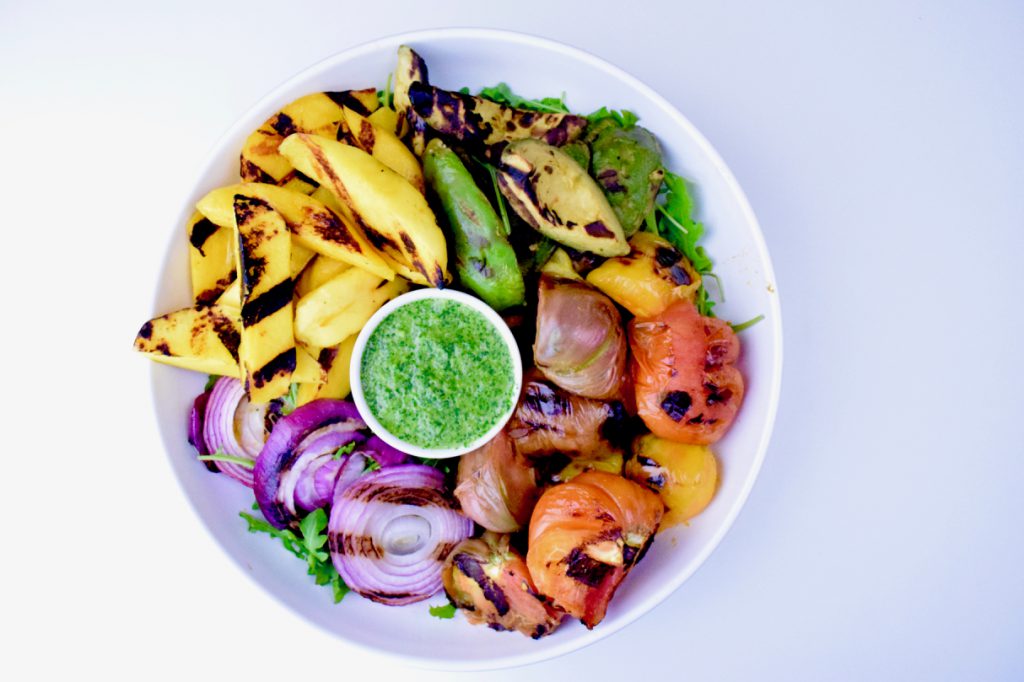Let’s be honest. There are things that we all know are good for us, but we just don’t feel like, or don’t get around to, eating. For many of us, that’s vegetables. Clients tell me all the time: ‘I don’t have time to wash, peel, cut and cook them!’ Or, ‘I buy them and they sit in my fridge and I have to throw them away!’ Or, ‘Steamed vegetables all the time gets boring.’ Any of that sound familiar? Nutritionists always tell people to eat more vegetables—but how? If you don’t know how to prepare them, you aren’t going to eat them.
Just a salad doesn’t cut it. We want to eat both raw and cooked vegetables. For example, look at tomatoes. When raw they are a fabulous sources of Vitamin C, an antioxidant. But unless you cook them, you don’t activate lycopene, which is a potent antioxidant, and especially so for men—it’s a prostate cancer-fighting chemical. You can find concentrated lycopene in canned tomato products also. So for today, let’s talk other things than salad, that are delicious, won’t make you bored, and will let you cook at home even on a busy schedule.
1.) Roasted vegetables: This is a dish you can make in a huge batch on the weekend, and eat throughout the week. You will need a roasting pan, and a large quantity of tomatoes, zucchini, bell peppers, red onion, and brussel sprouts or whatever you like. Cut the veggies in big chunks—not little pieces, and they don’t need to be pretty or uniform. Set oven to a high temperature—about 400 to 450 degrees Fahrenheit. Spray the roasting pan with cooking oil spray like canola oil and place the vegetables in a single layer in the pan. Sprinkle a little salt, pepper and garlic powder to taste with a drizzle of olive or canola oil. Put the pan on the middle rack of the oven for about 15 minutes; take it out, stir the veggies around (again ending with them in a single layer), and return the pan to the oven for another 10 minutes. Cook to taste—a little less for crunchy, a little longer for soft. You can eat them while warm, but refrigerate the leftovers. Throughout the week you can put them in soups, omelettes, lasagna, pasta sauce, stew—or just reheat and eat plain. Easy meal prep!
2.) Raw vegetable snack: Ok, so this isn’t cooked—but it isn’t salad, either, and it’s pretty delicious. Get a container of Greek yogurt; mix with a tablespoon or two of honey mustard and use as a vegetable dip. You’ll get probiotics, protein and it’s low calorie and delicious. For a less sweet version, use garlic powder in place of mustard. Bell peppers, broccoli and carrots are all great dipping implements for this one. Fermented vegetables are also a great raw vegetable option you can eat as a snack and can be full of your favorite flavors and spices when you make them yourself.
3.) Cauliflower: Raw cauliflower raw is good for you, but cooked has a different spectrum of beneficial chemicals. Roast two heads of cauliflower, just as you did the vegetables above: cut it in big chunks, spray it with olive oil, sprinkle with salt, pepper, and garlic powder and roast it in a hot oven. Once it’s cooked, either eat as is, or make a cream. Sauté lots of garlic and onions in a tablespoon of olive oil until they’re a little brown. Pour into a blender and add the cauliflower, plus vegetable broth. Blend to liquify. Pour that mixture back into a pot, add salt to taste, and it’s ready to go. A cup of it along with a healthy dinner will go a long way toward getting your veggie servings on track.
4.) Grilled vegetables: Rethink what you put on the grill besides your favorite meat. Consider adding a variety of foods, such as fruits and vegetables, to your grilling repertoire. Beef up your grill by adding vegetables such as zucchini, eggplant, tomatoes and corn to add a dose of nutrition with an array of different health benefits with that flavorful hit of smoke. Throwing in fruits like mango, avocado, and peaches add a different layer of flavor because you allow the natural sugars to caramelize on the fire. You can eat these as side dish to your meats, as snacks, skewers or even by making a warm grilled salad. Delicious!
5.) Stir fry: If you use vegetable or chicken broth in place of oil. Stir fry can be back on the menu. Pour some broth into a wok, toss in the vegetables, and season as you like. You can use soy sauce for an Asian flavor, or oregano for Italian. Also, in a stir fry, fresh herbs go a long way—fresh basil or parsley for Italian, or fresh cilantro for Asian flavor. The presence of fresh herbs will hugely enhance the flavor. As with the roasted veggies and the soup, you can make this in advance and save it. During the week, just briefly reheat and pour over chicken or rice.






